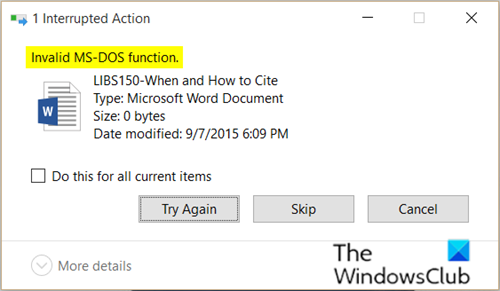This is actually a file-system error that often influences the file functionality only. You could experience the error also if you try to move a file from an NTFS format drive to a FAT32 format drive and a corrupt system file can also trigger the error.
Invalid MS-DOS Function file error
If you’re faced with this Invalid MS-DOS Function issue, you can try our recommended solutions below in no particular order and see if that helps to resolve the issue. Let’s take a look at the description of the process involved in relation to each of the listed solutions.
1] Run CHKDSK
Using CHKDSK is also one solution that is proved to be effective to fix the Invalid MS-DOS Function issue. To run CHKDSK, do the following: Press Windows key + R. In the Run dialog box, type cmd and then press CTRL + SHIFT + ENTER to open Command Prompt in admin/elevated mode. In the command prompt window, type the command below and press Enter. You will receive the following message: Press the Y key on the keyboard and then reboot your computer to let CHKDSK to check and fix the errors on the computer hard drive. After CHKDSK completes, check to see if the issue is resolved.
2] Shorten the name of the file that you’re copying
In this solution, simply shortening the file name could help resolve the error when you try to move, delete, copy or rename files/folders in Windows 10. If this fix doesn’t work, you can try the next solution.
3] Optimize and Defragment your drive
You can use the Windows snap-in tool to optimize and defragment the hard drive on your computer. You can follow these steps to do the job:
Press Windows key + E at the same time to open File Explorer.Click This PC.Right-click on the drive and then select Properties > Tools > Optimize > Optimize.
Once the procedure completes, restart your PC and check if the Invalid MS-DOS Function issue is resolved. If not continue with the next solution.
4] Format the destination drive in NTFS format
If the destination drive is not formatted as New Technology File System (NTFS), you may encounter the Invalid MS-DOS Function error. In this case, you can convert the destination drive to NTFS and see if that helps. Here’s how: Converting a drive using these steps will preserve the files on the drive. We still recommend making sure you have backups of all files on the drive. Find the letter of the drive you want to convert. Open File Explorer, and in the left pane, look for the drive under This PC or Computer. Press the Windows logo key + R to open the Run dialog box. Type cmd and hit Enter to open the command prompt window. At the command line prompt, type the command below and hit Enter. Replace the drive: placeholder with the actual letter of the drive. Once the format process completes, try the file action again and see if the issue is resolved. If not continue with the next solution.
5] Create and configure CopyFileBufferedSynchronousIo registry key
Some users said that they were able to resolve the Invalid MS-DOS Function issue by editing system policy in Registry Editor. Here’s how: Since this is a registry operation, it’s recommended you back up the registry or create a System Restore Point in case something goes wrong. Once you have taken the necessary precautionary measures, you can proceed as follows: Press Windows key + R. In the Run dialog box, type regedit and press Enter to open Registry Editor. Navigate or jump to the registry key path below: Right-click on the blank space on the right pane and then select New > DWORD (32-bit) Value. Rename the value name as CopyFileBufferedSynchronousIo and hit Enter. Double-click on the new value to open it. Type 1 in the Value data box and press Enter to save the change. You can now exit Registry Editor and restart your PC. On boot check, if the issue is resolved. Any of these solutions should fix the issue for you?

